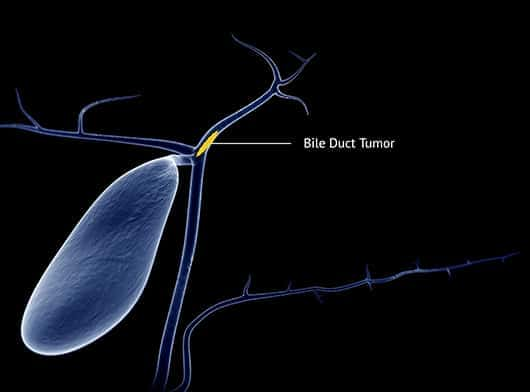- Surgery
- Radiation
- Medical Oncology
- Surgery is the primary mode of treatment in Cholangiocarcinoma. The type of surgery depends on the location of the tumor. The following types of surgery are used to treat bile duct cancer:
- Extrahepatic Bile duct resection (Removal of the Bile Duct) : Removal of a part of the bile duct when the tumor is small and confined to the extrahepatic bile duct without involvement of pancreas and liver.
- Partial Hepatectomy : Removal of the part of the liver affected by cancer. The section of tissue removed may be a wedge of tissue, an entire lobe, or a larger part of the liver, along with some normal tissue around it.
- Whipple Procedure : In distal Cholangiocarcinoma, a Whipple procedure is required to completely remove the tumor. Whipple procedure involves the removal of Head and neck portion of pancreas along with duodenum, distal stomach, bile duct, gall bladder and proximal jejunum.
- Liver Transplant : This is an option in selected cases as deemed fit by the treating doctor. Prior to a liver transplant, the patient is treated with either radiation and/ or chemotherapy.
- Palliative Biliary Drainage :It is a procedure to restore the flow of bile and relieve jaundice and can be done either through ERCP or Percutaneous transhepatic biliary drainage. In certain cases a surgical bypass procedure such as hepaticojejunostomy is done. Biliary drainage is required to relieve jaundice and then initiate systemic therapy for management of cholangiocarcinoma.
- This treatment uses high-powered energy from sources such as X-rays to destroy cancer cells and shrink tumors. The energy is directed to the liver, while sparing the surrounding healthy tissue.
- SBRT - Liver malignancies either primary (hepatocellular carcinoma) or secondary (metastasis) can be controlled using a technique called Stereotactic Body Radiotherapy using CyberKnife or Linear Accelerator.
- Proton therapy - It is a modern Radiotherapy technique in which liver tumors can be treated successfully with minimal dose to the surrounding normal tissues.
Chemotherapy uses drugs to destroy cancer cells. The indication for chemotherapy is based on the stage of cancer and risk factors.
Chemotherapy may be used before surgery to shrink large tumors which makes it easier for removal of the tumor.
Few patients may require chemotherapy after surgery which helps to kill any residual cancer cells. It is also indicated in cases when the disease has spread to other parts of the body.
It may also be an option for people with advanced cholangiocarcinoma to help slow the disease and relieve signs and symptoms.
The indication for targeted therapy is based on molecular changes in the cancer cell. This is usually combined with chemotherapy and may be an option in selected cases.
In case of recurrent disease, based on the molecular alterations noted in the tumor, specific targeted therapy is also an option.
Immunotherapy is a drug treatment that uses the immune system to fight cancer. Immunotherapy may be an option in selected patients who have advanced disease and recurrent disease.



.png)
